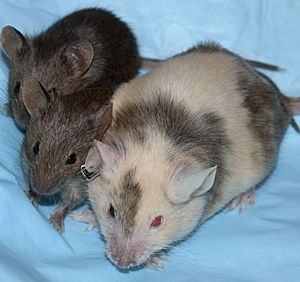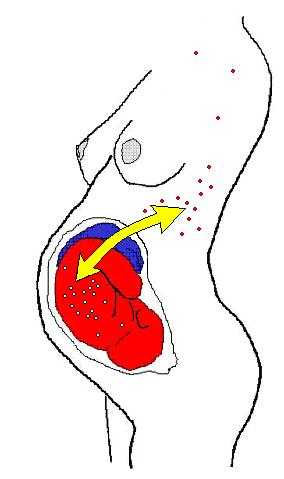Chimaera (genetics) facts for kids


A chimera (pronounced ky-MEER-uh) is a single living thing, usually an animal, that is made up of two different kinds of cells. These cells have different DNA. Imagine building something with two different sets of LEGO bricks! These different cells might come from two separate fertilized eggs or from different parts of the same early embryo.
When a chimera forms from two different fertilized eggs that join together, it's called a dispermic chimera. Each group of cells keeps its own features. So, the animal ends up being a mix of both. For example, it might have patches of different colored fur.
Sometimes, the different cells come from the same original fertilized egg. In this case, the organism is called a mosaic. It's a bit like a mosaic artwork, where different pieces make up one picture.
What is Microchimerism?
Microchimerism is a special type of chimera where an organism has a very small number of cells that are genetically different from its own. This can happen in a few ways:
- Blood transfusions: If someone receives a blood transfusion, they might get a few cells from the donor.
- Organ transplants: After an organ transplant, the person might have cells from the donor organ.
- During pregnancy: This is a common way microchimerism happens. During pregnancy, tiny cells can travel back and forth between the mother and the baby through the placenta. These cells can even multiply and stay in the body for many years after the baby is born.
Scientists have also found something called epigenetic chimeras in mice. This means the cells are genetically the same, but they act differently because of how their genes are turned on or off.
Germline Chimerism: Passing on Different Genes
Germline chimerism happens when an animal's sperm or egg cells are not genetically the same as the rest of its body cells. This is very interesting because it means the animal could pass on genes to its offspring that are not its own.
A great example of this is with Marmosets. These small monkeys almost always have fraternal twins. What's amazing is that marmosets can have the reproductive cells (sperm or eggs) of their twin siblings! This happens because their placentas often fuse together when they are developing inside their mother's womb. This allows cells to move between the twins, including the cells that will become their reproductive cells.
Related Topics

